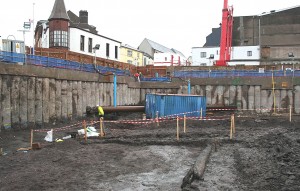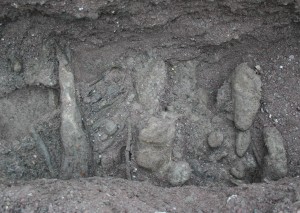Evidence for a medieval flood at Emmet Place

During archaeological monitoring of the excavation for the basement at Opera Lane Developement by Sheila Lane and Associates (Deborah Sutton 2008), a range of detritus was uncovered in the northeast corner that consisted of leaves, twigs, small branches, mud balls as well as a two artefacts, described as a worked timber post and struck flint. A few tree trunks were also observed at the site. At the time of the discovery, the excavation had been taken down to about 2m below mean sea level. Preliminary radiocarbon dating indicated that the wood fragments were deposited in the 10th century, while dendrochronology provided an age of AD 765 ± 9 for the post.

The context for this assorted material is interpreted as a major channel filled with coarse sand, adjacent to a gravel bar. Importantly, the mud balls indicate that there was erosion of a pre-existing mudflat to form fragments that were then rolled into ellipsoidal shapes. Interestingly, both the wood detritus and mud balls were aligned in more than one direction indicating that there were different current flows at the time of deposition, generated perhaps, by both river and tide. It seems likely, therefore, that in the tenth century the detritus was eroded in a torrential flood associated with a storm event. Presumably, the timber post was also swept downstream, and it has been suggested that it came from a riverside structure such as a revetment or a bridge (Deborah Sutton, personal communication). The large volume and diversity of drifted material suggests that the flood caused firstly, considerable scour of existing sediments and vegetation in the vicinity of the North Channel, and secondly, reactivated an old channel in the vicinity of Emmet Place. As a result a loop of the North Channel was reformed (Beese 2012) in a process known as avulsion. The overlying silt sequence, which was observed within the sand channel, was probably deposited during the subsequent recovery period, when normal tidal conditions resumed.

The immense power of the River Lee was most recently observed on November 19th and 20th, 2009, when an unprecedented discharge of water in the Lee valley caused the destruction of part of the quay at Grenville Place, which is situated on an outside bend of the North Channel. It seems likely that if the quay had not been in existence, then the river would have eroded a new and straighter channel under the Mercy Hospital.
